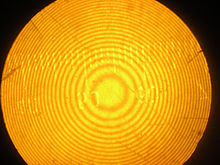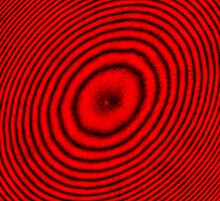
Back حلقات نيوتن Arabic Nyuton halqaları Azerbaijani Кольцы Ньютана Byelorussian Нютонов пръстен Bulgarian Newtonsche Ringe German Anillos de Newton Spanish Newtoni rõngad Estonian حلقههای نیوتن Persian Newtonin renkaat Finnish Anneaux de Newton French



Newton's rings is a phenomenon in which an interference pattern is created by the reflection of light between two surfaces, typically a spherical surface and an adjacent touching flat surface. It is named after Isaac Newton, who investigated the effect in 1666. When viewed with monochromatic light, Newton's rings appear as a series of concentric, alternating bright and dark rings centered at the point of contact between the two surfaces. When viewed with white light, it forms a concentric ring pattern of rainbow colors because the different wavelengths of light interfere at different thicknesses of the air layer between the surfaces.
© MMXXIII Rich X Search. We shall prevail. All rights reserved. Rich X Search